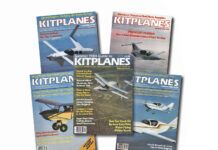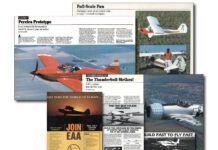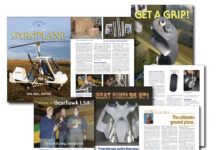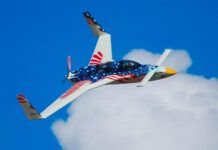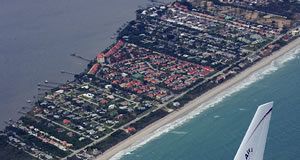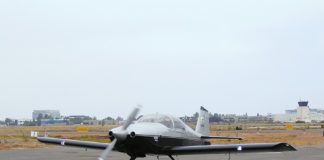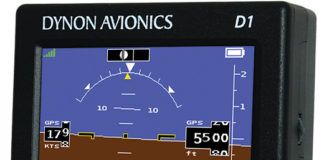 When this magazine was founded in 1984, aircraft navigation systems were just starting what would be seen as a paradigm shift. Before that time, orthodoxy prevailed. Most certified aircraft and the larger homebuilts had a pair of nav/coms-one with ILS capability and one just a VOR, a transponder, maybe DME (distance measuring equipment) and ADF (automatic direction finder). Higher-end aircraft might have a rho-theta area nav system, sometimes just called RNAV, which calculated a point in space based on the radial and DME from a VOR. Woo, heady stuff.
When this magazine was founded in 1984, aircraft navigation systems were just starting what would be seen as a paradigm shift. Before that time, orthodoxy prevailed. Most certified aircraft and the larger homebuilts had a pair of nav/coms-one with ILS capability and one just a VOR, a transponder, maybe DME (distance measuring equipment) and ADF (automatic direction finder). Higher-end aircraft might have a rho-theta area nav system, sometimes just called RNAV, which calculated a point in space based on the radial and DME from a VOR. Woo, heady stuff.
Change was on the horizon. A company called II Morrow developed a line of loran-C receivers for aircraft that promised true area navigation. Loran, which stands for long range aid to navigation, was developed from a British long-range system called GEE during WW-II. Using low-frequency, high-power fixed transmitters, loran calculated the receivers location based on the difference in time signals from two ground stations. Because it was first employed in marine applications, the transmitters were placed near the coasts, making airborne use of loran sketchy in the middle of North America. The signals were also subject to atmospheric disturbances and precipitation static in the aircraft. Whats more, the early lorans had no internal database. You typed in the latitude and longitude of your destination, and it took you there.
Eventually, of course, loran developed into a vital and useful navigation aid, with Arnav, Northstar and II Morrow the industry leaders for many years. Gradually, receiver technology improved and databases became more common and more detailed. For many pilots, the loran became the de facto primary navigator because it provided accurate ground track and speed, particularly useful when the aircraft was out of DME range. Northstar led the way in human factors, with a simple one-line display and a pair of concentric knobs that determined nav modes and entered new waypoints.
Kaboom!
Loran didn’t stand a chance against a new technology, though, in GPS. The military had begun launching navigation satellites in the 1970s, but it wasn’t until December 1993 that GPS achieved initial operational capability, and in April of the next year it was declared fully operational. By this time, computer technology and component miniaturization had become far more sophisticated, so even the earliest consumer GPS products seemed fantastic.
A small two-man start-up company named Garmin jumped in with a ruggedized, battery-powered model called the GPS 100. It was sized to fit in a panel, but many certified pilots carried the unit atop the glareshield. Then, as today, enterprising homebuilders constructed the miracle navigator right into the panel.
Overnight, GPSs accuracy and reliability put the serious hurt on loran. It worked all over North America, needed only a tiny antenna, and generally had a full database of airports and navaids, making its integration into the IFR mindset (as a means of situational awareness) complete. Although II Morrow, before its purchase by UPS and, later, by Garmin, developed a slick GPS/loran combo unit, other companies essentially abandoned loran for GPS.
About this time, we begin to see homebuilts eschewing the traditional pair of nav/coms plus DME for a single nav/com and GPS. In some cases, for pilots never intending to penetrate a cloud, the ground-based navigation receiver was completely forgotten. Give us a GPS and a com radio and were good to go, thanks.
TIMELINE May 1987 – February 1988
May 1987
Concern over the structural integrity and durability of composites was expressed in the magazines Intercom column (a Q&A where readers queries could be addressed). Designer Ed Swearingen was cited as having said that, No one knows for sure how long composite structures will last. However, the use of structural fiberglass went back to the 1960s, and many of those aircraft were still flying. The short answer was that the jury was still out, but general indications were that a properly designed, well-built composite aircraft would last a long time, especially if it was protected in a hangar.
This column also marked the demise of the SP 440 rotary engine, which had been developed for small aircraft and was used on the Dawnstar ultralight.
Dave Martin, in the Twice Around the Patch column, discusses the FAAs call for greater restrictions on airspace near urban areas. The announcement required that aircraft have transponders with Mode C (altitude reporting), and the change had been set in motion beforea summer 1986 collision between a lightplane and an airliner in Cerritos, California. However, that accident may have hastened the process. It was also predicted that the FAA would soon require Mode-C transponders in all areas-in, under and around TCAs, all the way to the ground.
The all-new Phoenix aircraft, out of Oceanside, California, is touted as the Aircraft for the Future: Speed, Safety, Economy and Performance. Not to be confused with the three-seat amphibian called the Phoenix, out of Woodland, Washington, also new this year.
Stan Halls plansbuilt Cherokee II wood motorglider is profiled. Said the article, Halls hope was to offer anyone with a modicum of wood-working, model-airplane-building, handyman talent and willingness to work, the means to glide and soar!
The exotic Legeti Stratos closed-wing composite debuted at Oshkosh in 1986 and was featured in May 1987. Described as an ultra-aircraft-ultra-light, ultra-compact and ultra-high performing, the Stratos weighed just 172 pounds empty and claimed a max cruise of 112 mph (which placed it out of the U.S. ultralight category). It was the brainchild of Romanian-born Charles K. Ligeti. Power was from a three-cylinder Koning engine producing 28 hp at 4200 rpm. Price: $8000 for the kit.
June 1987
An advertisement for the Zenair STOL CH 701 lists the kit price as $11,300. Twenty-one years later, the Zenith Aircraft web site lists the current CH 701 prices as $10,975 for the airframe kit and $3195 for the finishing kit (total $14,170).
An article by Richard Finch seeks to allay skepticism about auto engine conversions for aircraft, which continue to be a topic of interest to homebuilders, despite some reservations. As ever, the lower cost of the engine is the primary motivator. The Fred Geschwender Ford V-8 and Offenhauser Oldsmobile 225-hp V-8 are featured.
A full-page ad touts II Morrows Apollo 64 Equalizer, with an expanded Flybrary database cartridge and nav displays. This loran features a huge database that can be updated every 56 days by simply changing a cartridge! Additionally, it keeps track of the five nearest airports, five nearest VORs and the five nearest user waypoints.
January 1988
The new Murphy Renegade Spirit ultralight prototype is reviewed. Fully aerobatic, the Renegade had a patented extruded aluminum gusset system used to join the aircraft tubular members together. Power is from a two-stroke Rotax 532.
The first 25 production positions for the Gambit 600 from Israel is advertised. For only a $500 deposit, you could reserve an early delivery position. Complete kit: $17,950. Dealerships also available.
A feature details how P.H. Spence Spencer is looking for new, younger management for his Spencer Air Car company. Spencer, then 90 years old, was the oldest licensed pilot in the U.S. at the time. He designed the Republic Seabee at the end of WW-II. His partner, Andy Anderson, was 77. Air Cars were flying in New Zealand, Brazil and Canada. Asking price for the company: $160,000.
A letter to the editor makes a request: Address the question we low-time, spam-can fliers ask: Can a good Experimental design offer the docile, forgiving handling qualities of a Cherokee or C-172, equivalent or better payload, and give better cruise speed and fuel economy? The writer claims that articles have hinted at the answer, but he wants the question addressed head-on. Thats what everybody asks, he writes.
February 1988
Ken and Gail Wheelers four-seat Wheeler Express composite kit, introduced at Oshkosh in 1987, is reviewed. Also in the works was a Wheeler Alaskan amphibian. Ken Wheeler said that though building an Express would never be a casual enterprise, he wanted to make it manageable for a novice.
Vision Microsystems offers a new line of engine instruments for homebuilt aircraft, estimated to have an error rate of from 1% to 3%, as opposed to a 14% to 25% error for gauges of the old days. Lance Turk, company president, prompted to innovation by looking for gauges for his Glasair, explains how computer technology allows for high precision, fast action, direct reading, lightweight, minimum-depth gauges.

